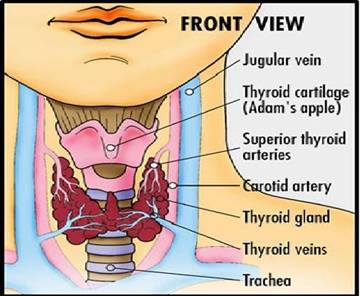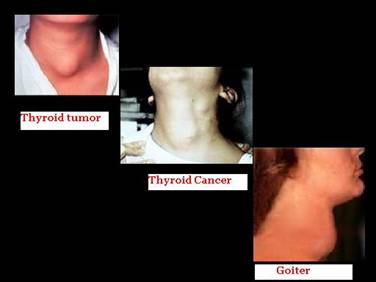|
THYROID CANCER
Thyroid cancer occurs when cells of the thyroid gland grow uncontrollably to form tumors that can invade the tissues of the neck spreading themselves to the surrounding tissues of the neck as well as the bloodstream and then to other parts of the body. The most common types of thyroid gland cancer originate in the cells responsible for thyroid hormone production.The general term for cancers that come from glandular tissue is adenocarcinoma.
Alternative Names Tumor - thyroid; Cancer - thyroid
Causes, incidence, and risk factors
Thyroid cancer can occur in all age groups. People who have had radiation therapy to the neck are at higher risk. This therapy was commonly used in the 1950s to treat enlarged thymus glands, adenoids and tonsils, and skin disorders. People who received radiation therapy as children have a higher incidence of thyroid cancer.
Other risk factors are a family history of thyroid cancer and chronic goiter. The disease affects 1 in 1,000 people.
There are several types of thyroid cancer:
· Papillary carcinoma is the most common and usually affects women of child-bearing age. It metastasizes (spreads from the original site) slowly and is the least malignant type of thyroid cancer. · Follicular carcinoma accounts for about 30% of all cases and has a greater rate of recurrence and metastasis. Medullary carcinoma is a cancer of non-thyroid cells in the thyroid gland and tends to occur in families. It requires different treatment from other types of thyroid cancer. Anaplastic carcinoma (also called giant and spindle cell cancer) is the most malignant form of thyroid cancer. It is rare, but does not respond to radioiodine therapy. Anaplastic carcinoma metastasizes quickly and invades nearby structures such as the trachea, causing compression and breathing difficulties.
Symptoms · Enlargement or a nodule of the thyroid gland or neck swelling · Hoarseness or changing voice · Cough or cough with bleeding Difficulty swallowing
Note: Symptoms may vary depending on the type of thyroid cancer
Signs and tests
A physical examination can reveal a thyroid mass or nodule (usually in the lower part of the front of the neck) or enlarged lymph nodes in the neck.
Tests that indicate thyroid cancer:
Thyroid biopsy showing anaplastic, follicular,medullary or papillary carcinoma cells Ultrasound of the thyroid revealing nodule Thyroid scan showing cold nodule (a nodule that does not light up on scan) Laryngoscopy showing paralyzed vocal cords Elevated serum calcitonin (for medullary cancer) or serum thyroglobulin (for papillary or follicular cancer)
This disease may also alter the results of the following tests: T4 T3 TSH
Treatment Treatment varies depending on the type of tumor.
Surgery is usually the treatment of choice, with usually the entire thyroid gland removed. If the physician suspects that the cancer has spread to lymph nodes in the neck, these will also be removed during surgery.
Radiation therapy with radioactive iodine is often used with or without surgery. Radiation therapy with beam radiation can also be used.
After treatment, patients need to take thyroid hormone to replace what their glands used to make. The dose is usually a little higher than what the body needs, which helps keep the cancer from coming back.
If the cancer does not respond to surgery or radiation and has spread to other parts of the body, chemotherapy may be used, but this is only effective for about a third of patients.
Endocrine glands release hormones (chemical messengers) into the bloodstream to be transported to various organs and tissues throughout the body. For instance, the pancreas secretes insulin, which allows the body to regulate levels of sugar in the blood. The thyroid gets instructions from the pituitary to secrete hormones which determine the pace of chemical activity in the body (the more hormone in the bloodstream, the faster the chemical activity; the less hormone, the slower the activity) |



|
TOP |









